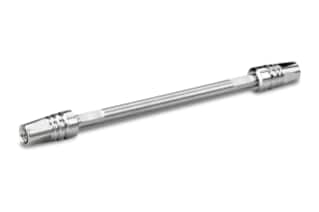
|
Chemistry |
C18 |
|
Separation Mode |
Reversed Phase |
|
Particle Substrate |
Silica |
|
pH Range Min |
1 pH |
|
pH Range Max |
8 pH |
|
Temperature Limits |
45 C |
|
Maximum Pressure |
18000 psi (1240 Bar) |
|
Endcapped |
Yes |
|
Silanol Activity |
Low |
|
Particle Shape |
Spherical |
|
Particle Size |
1.8 µm |
|
Endfitting Type |
Parker-style |
|
Pore Size |
100 Å |
|
Format |
Column |
|
Surface Area |
230 |
|
System |
UPLC, UHPLC |
|
Particle Technology |
HSS |
|
USP Classification |
L1 |
|
Inner Diameter |
1 mm |
|
Length |
100 mm |
|
Carbon Load |
15 % |
|
eCord |
Yes |
|
UNSPSC |
41115709 |
|
Brand |
ACQUITY UPLC |
|
Product Type |
Columns |
|
Units per Package |
1 pk |

ACQUITY UPLC HSS C18 Column, 100Å, 1.8 µm, 1 mm X 100 mm, 1/pk
When compared to ACQUITY UPLC BEH C18 columns, the ACQUITY UPLC HSS C18 chemistry offers higher retention, superior peak shape for bases, and exceptionally long column lives at low pH. ACQUITY HSS C18 columns are fully scalable and adaptable to HPLC separations.
The ACQUITY UPLC HSS C18 SB Column will consistently deliver results year after year since it was built to provide dependable and reproducible results. HPLC separations can use the fully scalable ACQUITY HSS C18 SB columns. The lab apparatus is also used to separate complex mixtures of basic and non-basic chemicals at low pH.
Use the novel non-end-capped, low-coverage silica-based C18 chemistry of the ACQUITY UPLC HSS C18 SB Column to achieve alternative selectivity for compounds affected by silanophilic interactions. Due to secondary interactions with remaining silanols, the lab apparatus has a distinctively elevated silanol activity, which increases the retention of basic compounds. Low ligand density and ionic repulsion, which decrease non-basic analyte retention, are the causes of this. The ACQUITY UPLC HSS C18 SB Column is a potent technique development tool for imparting changes in Selectivity for Bases (SB) while creating excellent peak shape due to its distinctive combination of retention qualities.
The ACQUITY UPLC HSS C18 SB Column's packaging materials were created expressly for use with the ACQUITY UPLC System. On our website, you can browse to shop for lab equipment, perform a product compatibility search to locate all items that match the current selection or look for multiple iterations of the same listing.
You may also be interested in MassPREP E. coli Digest Standard; The Waters Protein Expression System's MassPREP E. coli digestion standard (MPDS E. coli) is designed to offer a complex biological matrix for creating samples used to train new users. MPDS E. coli was created by using sequencing-grade trypsin to digest a pure E. coli cytosolic protein fraction. The MPDS mixture is purified and free of trypsin, undigested protein, salts, and other substances with high hydrophilicity.
What Is The Mass Spectrometry Principle In Liquid Chromatography?
The fundamental idea behind mass spectrometry (MS) is to create ions from either inorganic or organic compounds using any method that is suitable. These ions are then separated according to their mass-to-charge ratio (m/z), and their respective m/z and abundance are used to detect the ions both qualitatively and quantitatively.